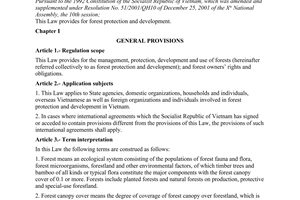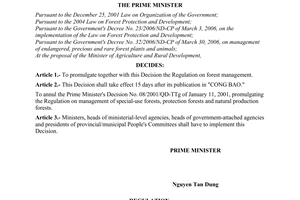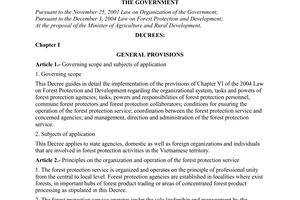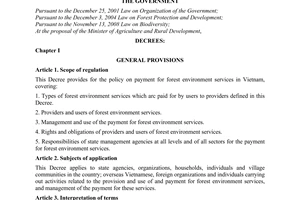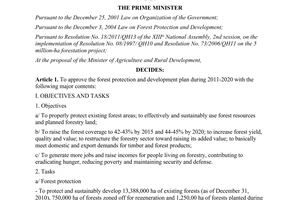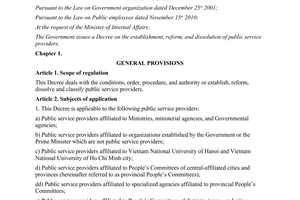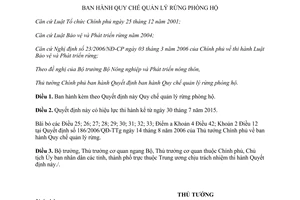Decision No. 17/2015/QD-TTg regulation on protective forest management đã được thay thế bởi Decree 156/2018/ND-CP on enforcement of a number of articles of the Law on Forestry và được áp dụng kể từ ngày 01/01/2019.
Nội dung toàn văn Decision No. 17/2015/QD-TTg regulation on protective forest management
|
THE PRIME
MINISTER |
SOCIALIST
REPUBLIC OF VIETNAM |
|
No.: 17/2015/QD-TTg |
Hanoi, June 09th 2015 |
DECISION
PROMULGATING THE REGULATION ON PROTECTIVE FOREST MANAGEMENT
Pursuant to the Law on Government organization dated December 25, 2001;
Pursuant to the Law on Forest Protection and Development 2004;
Pursuant to the Decree No. 23/2006/ND-CP dated March 03th 2006 by the Government on the implementation of the law on Forest Protection and Development;
At the request of the Minister of Agriculture and Rural development,
The Prime Minister promulgates the Decision promulgating the Regulation on protective forest management.
Article 1. Enclosed with this Decision the Regulation on protective forest management.
Article 2. This Decision comes into effect from July 30th 2015.
Articles 25, 26, 27, 28, 29, 30, 31, 32, 33; Point a Clause 4 Article 42; Clause 2 Article 12 of Decision No. 186/2006/QD-TTg dated August 14th 2006 by the Prime Minister on promulgating the Regulation on forest management are annulled.
Article 3. The Minister, Heads of ministerial-level agencies, Heads of Governmental agencies, the Presidents of People’s Committees of central-affiliated cities and provinces are responsible for implementing this Decision./.
|
|
THE PRIME
MINISTER |
REGULATION
ON
PROTECTIVE FOREST MANAGEMENT
(Enclosed with the Decision No. 17/2015/QD-TTg dated June 09th
2015 by the Prime Minister)
Chapter I
GENERAL PROVISIONS
Article 1. Scope of regulation
This Regulation provides for the management, protection, development and use of protective forests, enjoyment of benefits from protective forests and investment in protective forests.
Article 2. Regulated entities
This Regulation applies to regulatory agencies, organizations, village communities, households and individuals in Vietnam; Vietnamese living overseas; organizations and individuals relevant to the management, protection, development and use of protective forests in Vietnam.
Article 3. Interpretation of terms
In this Regulation, these terms can be construed as follows:
1. Subsidiary plants mean plants grown together with major ones for a certain period aiming to create biotope to boost the latter’s grown and development.
2. Intercropped plants mean plants grown in combination with major ones, aiming to make full use of land and the nutritious space so as to increase outputs and profits on forest areas without adversely affecting the growth and development of primary plants.
3. Primary plants mean forestry plants grown for protective purpose.
Chapter II
PROTECTIVE FOREST MANAGEMENT
Article 4. Classification of protective forests
1. Headwaters protective forests
a) Headwaters protective forests mean forests established to enhance water source-regulation capability of water flows and reservoirs, thereby restricting floods, reducing erosion, protecting land and restricting the extension with deposits of lakebed and downstream areas;
b) Headwaters protective forest area includes the forest areas and planning forestry land according to the regulations of the state mainly for the protection and development of headwaters protective forests.
The size of headwaters protective forests shall be compatible with the size of river/lake basins and the management of headwaters protective forests shall be associated with the comprehensive management of river/lake basins.
2. Wind- and sand-shielding protective forests
a) Wind- and sand-shielding protective forests shall be established to reduce the strength of wind and stop moving sand, protect residential quarters, urban centers, production areas and other works;
b) Wind- and sand-shielding protective forest area includes the forest areas and planning forestry land according to the regulations of the state mainly for the protection and development of wind- and sand-shielding protective forests.
3. Breakwater and sea encroachment prevention protective forests
a) Breakwater and sea encroachment prevention protective forests shall be established to hold back waves and prevent landslide and for protection of riverside and seaside works, maintaining the nature of ecosystem;
b) Breakwater and sea encroachment prevention protective forest area includes the forest areas and planning forestry land according to the regulations of the state mainly for the protection and development of breakwater and sea encroachment prevention protective forests.
4. Protective forests for environmental protection
a) Protective forests for environmental protection shall be established to regulate climate, combat environmental pollution, create natural landscape in residential quarters, urban centers and industrial parks, in combination with tourism and convalescence;
b) Area of protective forests for environmental protection includes the forest areas and planning forestry land according to the regulations of the state mainly for the protection and development of protective forests for environmental protection.
Article 5. Criteria for determination and classification of importance of protective forests
1. Headwaters protective forests are classified as important and very important as follows:
a) Very important forests
- The rainfall of over 2,000 mm per year or from 1,500 to 2,000 mm per year, concentrated in 2 to 3 months.
- Mountainous and hilly terrain with a height difference at over 50 m and a slope of over 35 degree; mountainous and hilly terrain with a height difference at 25 m to 50 m and a slope of over 25 degree; mountainous and hilly terrain with a height difference at under 25 m and a slope of over 15 degree.
- Height of at least 1/3 of the mountain from the top.
- Mechanic components and thickness of soil layer: type of soil, mixture soil, medium or thin soil layer with the thickness of 80 cm or lower; light or medium heavy-soil with the thickness of under 30 cm.
b) Important forests
- The rainfall of from 1,500 to 2,000 mm per year or from 1,000 to under 1,500 mm per year, concentrating in 2 to 3 months.
- Mountainous and hilly terrain with a height difference of at least 50 m and a slope of 26 to 35 degree; mountainous and hilly terrain with a height difference of 25 to 50 meters and a slope of 15 to 25 degree; Mountainous and hilly terrain with a height difference of at least 25 meters and a slope of 8 to 15 degrees.
- Height of 1/3 of the mountain at its middle (mountain side).
- Sand soil, mixed soil, thick soil layer with the thickness of over 80 cm; light or medium heavy-soil with the thickness of 30 cm to 80 cm.
c) Additional criteria
During the classification of the importance of a protective forest, the important forest shall be upgrade to very important forest if it locates next to a key irrigational/hydroelectric reservoir/dam, city, town, highland traffic or if the protective forest locates on sides of a main river/stream or a lake/dam.
2. Criteria for determination of wind- and sand-shielding protective forests
a) Moving sand dune, adjacent yard to moving sand topography: sand mixed into rain/flood/storm water or inland area that is backfilled with sand damaging developing cities/towns/areas, infrastructural/cultural/social constructions at national or provincial level, concentrated agricultural and industrial establishments, villages, roads, bridges, culverts with area of more than 100 hectares;
b) Flat sand dune, coastal sand bank, inland area that will be backfilled with sand for 5 to 10 years damaging towns, center area of groups of communes, infrastructural, cultural and social works of provinces, interdistrict, groups of communes; places with few fields, small and sparse factories, villages, bridges, culverts that are predicted safe from sand for the next 5 years, with an area of under 100 hectare.
3. Criteria for determination of breakwater and sea-encroachment protective forests
a) Coastal areas or estuaries having dykes or dams with distance from the foot of the dyke/dam to the sea is 200 meters when the tide is at average height;
b) Coastal areas or estuaries that are eroded and do not have a dyke/dam, distance from the water edge to the sea is 500 meters when the tide is at average height. If the estuary is not eroded, the protection and production combined forests shall be determined to 200 meters from the water edge to the sea when the tide is at average height.
4. Protective forests for environmental protection are determined for specific works whose areas are decided by local governments according to current regulations.
Article 6. Criteria for determination of protective forest area
1. A protective forest will be determined if it satisfy the criteria specified in Clauses 2 and 3 of this Article.
2. General criteria for determination of protective forest area:
a) Plants shall cover at least 70 percent of the protective forest area;
b) Undivided forest shall cover at least 0.5 hectare, trees planted in range shall be 20 meters in width and have at least 03 rows of trees;
c) A protective forest is an ecosystem where main components are woody perennial plants, palms or bamboos with total height of 5.0 meters or more (excluding coastal mangrove forest plants).
3. Specific criteria for determination of protective forest area:
a) A headwaters protective forest is conformable to determination standard when it is capable of maintaining and regulating water source, protecting soil, reducing erosion. Canopy degree of very important headwaters protective forests shall be at least 0.8; canopy degree of important protective forests shall be at least 0.6;
b) A wind- and sand-shielding protective forest is considered conformable to determination standard when plants in such forest have canopies closed, activate the shielding effect against wind and sand for production areas and residential areas, increasing or stabilizing the productivity of industrial plants;
c) A breakwater and sea encroachment protective forest is considered conformable to the determination standard when plants in such forest have canopies closed, roots developed, the breakwater effect have been activated, stabilizing the soil, increasing the capability of filling the coast, preventing or reducing landslide, protecting coastal works;
d) A protective forest for environmental protection is considered conformable to the determination standard when the effects of air-pollution prevention and climate regulation have been activated, creating a fresh landscape and environment for industrial zones, urban zones, tourism and resort zones.
Article 7. Responsibility of regulatory bodies for management of protective forests
1. The Ministry of Agriculture and Rural Development shall unify the state management in protection, development and use of protective forests nationwide as follows:
a) Direct the formulation of plannings and plans on protection, development and use of protective forests;
b) Draw up regulations and guidance on the implementation of the regulation on management, protection, development and use of protective forests;
c) Conduct inspections, settle the disputes and handle the violations pertaining to the implementation of regulations on management, protection, development and use of protective forests according to the law provisions;
d) Direct and guide the statistics, inventory and supervision of the forest resources and formulation of protective forest management documents;
dd) Direct and guide the assignment, lease, withdrawal, change of protective-forest use purpose according to the legislation.
2. People’s Committees of central-affiliated cities and provinces (hereinafter referred to as People's Committees of provinces) shall perform the management of protective forests in local area as follows:
a) Organize the formulation of plannings and plans on protection and development of protective forests in their provinces, direct and guide the People’s Committees of districts to formulate plannings/plans on protection of protective forests in local areas;
b) Issue documents within their competence to direct People’s Committees of districts and communes and organizations, households and individuals in local area to implement the law provisions, policies and regulations on management, protection and development of protective forests;
c) Carry out the establishment, merger, separation and dissolution of the management board of protective forests according to the law provisions;
d) Classify forests, determine the boundaries and protective forest area of local area according to the guidance of the Ministry of Agriculture and Rural Development;
dd) Direct and guide the assignment, lease, withdrawal, change of protective-forest use purpose, recognition of the right to use protective forests according to the law provisions; the establishment and management of documents on assignment and lease of protective forest and forest land in local areas;
e) Direct the fire prevention and fighting and pest control in protective forests in local area; build up protective-forest protection networks, mobilize the forces to cooperate with forest management forces in preventing the damage to protective forests in their provinces;
g) Conduct inspections, settle the disputes and handle the violations pertaining to the implementation of regulations on management, protection, development and use of protective forests according to the law provisions.
3. Services of Agriculture and Rural development of provinces shall assist People's Committees of provinces to carry out the management of protective forests on various fields according to the regulations in Clause 2 of this Article.
4. People’s Committees of provincial-affiliated cities and districts (hereinafter referred to as People's Committees of districts) shall perform the management of protective forests in local area as follows:
a) Formulate plannings/plans on protection and development of protective forests of districts and submit them to competent agencies for approval and carry out the approved ones;
b) Issue documents within their competence and implement the legislation on protective forest protection and development in local areas;
c) Direct People’s Committees of communes, wards and towns (hereinafter referred to as People’s Committees of communes) to formulate plannings/plans on forest protection and development; plans on assignment and lease of protective forests; supervise and inspect the implementation of the regulations and the provisions of contracts on assignment, lease or allocation of protective forests to organizations/village communities/households/individuals (hereinafter referred to as protective forest assignees/lessees/allocation recipients) in local areas;
d) Determine the boundaries of protective forests in local areas;
dd) Produce statistics, check and supervise the development of protective forests in local areas;
e) Carry out the assignment, lease and withdrawal of protective forests to/from households, individuals and village communities;
g) Conduct inspections of the implementation of legislation on forest protection and development in local areas; impose penalties for violations within their competence.
5. People’s Committees of communes shall carry out the management of protective forests in local areas as follows:
a) Direct, expedite and guide households, individuals and village communities to implement the legislation on protection and development of protective forests in local areas;
b) Formulate plannings/plans on protection and development of local protective forests, plans on assignment/lease of forests and submit them to competent agencies;
c) Transfer the protective forests on field to the assignees/lessees/allocation recipients and verify the boundaries of protective forests on field;
d) Guide the village communities to formulate and comply with the regulations on management, protection and development of protective forests; organize and mobilize people in local area to cooperate with forest management forces, police and army forces in local area in finding out and stopping promptly the damage to protective forests;
dd) Conduct inspections and handle the violations within their competence;
e) Directly manage the protective forest areas that have not been assigned or leased out in local area and request People’s Committees of districts to use such forest areas.
6. If the protective forest is established in multiple districts, the management of protective forest under the management of the Services of Agriculture and Rural development, People’s Committees of districts/communes shall establish a cooperation in management and protection of protective forests within administrative division.
7. If a violation against Regulation on management, planning and investment in protective forests is committed; if the illegal deforestation or forest fire occurs causing serious consequence in an area but the responsible President of the People’s Committee does not take any measure for promptly preventing and handling, such people shall take responsibilities according to the law provisions.
Article 8. Management of protective forests
1. People's Committees of provinces shall decide the establishment of the management board of protective forests according to current regulations in the following cases:
a) The concentrated protective forest has an area of 5,000 hectares or above (applicable to headwaters protective forests) or 3,000 hectares or above (applicable to wind- and sand-shielding protective forests and breakwater and sea encroachment protective forests);
b) The dispersed protective forest plays an important role in headwaters protection, breakwater and sea encroachment protection or wind- and sand-shielding protection; total area of such forest within administrative division of a province is 5,000 hectares or more (applicable to headwaters protective forests) or 3,000 hectares or more (applicable to wind- and sand-shielding protective forests and breakwater and sea encroachment protective forests);
c) In special cases, any protective forests have area unconformable to the regulations in Points a and b of this Article that require the establishment of the protective-forest management board shall be approved by the Ministry of Agriculture and Rural Development.
2. Regarding protective forests that are not eligible for establishing the management board according to Clause 1 of this Article, the State shall assign or lease out to the armed units that are garrisoned in the same area or to the economic organizations, households, individuals or village communities that are residing lawfully in same area according to the law provisions.
Article 9. Regulations on protective-forest management board
1. Protective-forest management boards are responsible for the protective forests that are assigned by state. Rights and obligations of a Protective-forest management board are specified in Articles 59, 60 and 62 of the Law on Forest Protection and Development 2004.
2. Protective-forest management boards are public service units affiliated to the Services of Agriculture and Rural development that are established by People's Committees of provinces according to the laws.
3. Revenues from the development of forest products, ecotourism, forest environment services specified in Decree No. 99/2010/ND-CP dated September 24th 2010 by the Government on payment of forest environment services and other forestry services are balanced in financial plans of Protective-forest management board; benefits of such activities are shared according to of co-management structure and paid to contracted employees according toself-settlement structure
4. People's Committees of provinces shall define the functions, tasks, entitlements and organizational structure of Protective forest management boards according to the laws.
5. Payroll of Protective-forest management boards is determined according to the regulations on working positions provided in the laws. Protective-forest management boards shall formulate annual plans on payroll and submit them to competent agencies
Total payroll of a Protective-forest management board including officers, forest management forces (if any) and employees is determined on the basis that not exceeding 700 hectares per payroll.
Article 10. Regulations on protective-forest protection forces
1. Protective-forest protection units
Protective-forest protection units are established at Protective-forest management boards according to the regulations in Decree No. 119/2006/ND-CP dated October 16th 2006 by the Government and Decree No. 55/2012/ND-CP dated June 28th 2012 by the Government.
a) Presidents of the People’s Committees of provinces are in charge of giving decision on the establishment of Protective-forest protection units;
b) Protective-forest protection units are State administrative agencies affiliated to Sub-Department of Forest protection.
2. Specialized forest protection forces
Regarding protective forests that are not subject to establishment of Protection units according to Clause 1 of this Article, the Protective-forest management board shall establish a specialized forest protection forces as follows:
a) Protective-forest management boards shall establish and manage the affiliated specialized forest protection forces;
b) Forest protection sub-department of provinces shall provide specialized forest protection forces with guidance and assistance and cooperate with them in carrying out the professional measures.
Chapter III
PROTECTIVE-FOREST PROTECTION AND DEVELOPMENT
Article 11. Protective-forest protection
1. Contents of protective-forest protection
a) Protection of protective-forest ecosystem according to the law provisions on forest protection and development, environmental protection and biodiversity conservation;
b) Protection of forest plants and animals according to the law provisions on forest protection and development, environmental protection and biodiversity conservation;
c) Fire safety in protective forests according to the law provisions on forest protection and development and on forest fire prevention and fighting;
d) Prevention of organisms harmful to protective forests according to the law provisions on forest protection and development and law provisions on protection and quarantine of plants, law provisions on veterinary medicine.
2. Responsibilities of protective-forest protection organizations
a) Protective-forest management boards, assignees/lessees/allocation recipients of protective forests are responsible for protecting the assigned area of protective forest;
b) Forest protection sub-departments of provinces shall take responsibilities for arranging the local Forest protection forces and shall cooperate with Protective-forest management board in forest protection;
c) People’s Committees of communes shall organize the militia to assist the protective forests’ owners and protect the protective forest area that they have not assigned/leased out according to the regulations in Decision No. 07/2012/QD-TTg dated February 08th 2012 by the Prime Minister.
3. Allocation of protective forests, co-management and sharing of benefits from protective forests
Protective-forest management boards shall allocate the protective forests concurrently with the implementation of regulations on co-management structure and sustainable sharing of benefits from forest products and forest environment services with households, individuals and village communities according to current regulations.
Article 12. Protective-forest development
1. Headwaters protective forests shall maintain and gradually restructure the typical natural forest of area and species of plants having deep and firm roots.
2. Wind- and sand-shielding protective forest shall have at least 1 forest belt with the width of at least 20 meters that combines with the subsidiary forest belts to form a closed plot; protective forests for agricultural production and plants for forming forest belts shall be plants that are supple and have deep and firm roots.
3. Coastal areas where the reforestation is possible shall have breakwater and sea encroachment protective forests. If breakwater protective forest locates near to a river/stream, the width of forest belts shall be at least 1/3 of the width of the river/stream; if there are multiple forest belts, they shall be staggered; plants shall be water resistant and have deep and firm roots.
4. Protective forests for environmental protection shall be planted in belts, rows, plots and alternating green system in residential areas, industrial zones, tourism zones, creating fresh environment for entertainment and sightseeing and tourism; plants shall be evergreen plants with wide canopies, many flowers, beautiful and harmless.
5. Protective forest plants shall satisfy the regulations specified in Clauses 1, 2, 3 and 4 of this Article; the multi-purposes shall be developed to increase the revenues from protective forests.
Chapter IV
USE OF PROTECTIVE FORESTS AND ENJOYMENT OF BENEFITS
Article 13. Principles of development of forest products from protective forests
1. The development of forest products from protective forests must not decrease the protective function of forests and must conformable to the law provisions on forest protection and development, environmental protection and biodiversity conservation.
2. The limited amount is specified in Articles 14, 15 and 16 of this Regulation.
3. The extraction of valuable and rare animals/plants and species that are protected by the law from protective forests being natural forest is forbidden.
Article 14. Salvage cutting of timbers in protective forests being natural forests
1. Regarding very important headwaters protective forests, wind- and sand-shielding protective forests and breakwater and sea encroachment protective forests; protective forests for environmental protection being natural forests, extraction of timbers is forbidden.
2. Regarding important headwaters protective forests being natural forests, only the exploitation of trees, internodes, sticks and barks that are rotten, peeled, burnt wood; branches, tops and roots and the sustainable extraction of non-timber forest products are allowed; only the utilization of timbers and non-timber forest products on the site-clearing area for construction of works or for other purposes in natural forests being rich and average forests. After the extraction, if the forest is still conformable to the determination standards specified in Article 6 of this Regulation and current provisions on forest product extraction.
Article 15. Extraction of timbers from protective forests being planted forests
1. Regarding protective forests being planted forests that are invested by the state budget, only the extraction of intercropped plants and subsidiary plants, forest thinning, collection of laying timbers, rotten, peeled or burnt timbers, branches, tops, roots of trees suppose that the retained density of primary plants are 600 plants per hectare.
2. Regarding protective forests being panted forested subsidized by the state budget, programs and projects funded from the State budget.
a) Extraction of intercropped plants, subsidiary plants; forest thinning, salvage cutting;
b) Primary plants may be extracted when the standard for extraction is reached with amount of not exceeding 20 percent of the reserves supposed that the criteria specified in Article 6 of this Regulation are satisfied; primary plants can be fully extracted in interpose rows or patches with total area of extraction not exceeding 20 percent of conformable planted forest area and not exceeding 03 (three) hectares; such area shall be reforested in the next crop.
Extracted rows shall be designed according to the contour with the width of not exceeding 20 meters (applicable to very important headwaters protective forests) or 30 meters (applicable to important headwaters protective forests); extracted patches shall have an area of 01 hectare (applicable to very important headwaters protective forests) or 02 hectares (applicable to important headwaters protective forests).
3. Regarding protective forests being planted forests that the forest receivers/lessees invest themselves
a) Intercropped plants, subsidiary plants may be extracted; forest thinning, salvage cutting may be carried out;
b) Primary plants may be extracted when the standard for extraction is reached with amount of not exceeding 30 percent of the reserves supposed that the criteria specified in Article 6 of this Regulation are satisfied. The extraction shall be carried out according to the regulations in Points b Clause 2 of this Article.
4. The Ministry of Agriculture and Rural Development shall provide guidance on procedures for extraction of timbers from natural forest.
Article 16. Extraction of bamboo and non-timber forest products from protective forests
Protective-forest management boards; protective-forest assignees/lessees/allocation recipients may extract bamboos with amount of not exceeding 30 percent of the reserves supposed that the criteria specified in Article 6 of this Regulation are satisfied. The extraction of non-timber forest products shall comply with the principles of development of forest products specified in Article 13 of this Regulation.
Article 17. Ecotourism, scientific research, education and training in protective forests
1. Protective-forest management boards may organize, cooperate in organizing or lease out forest environment for trading in ecotourism, scientific research, education or training in protective forests.
2. The development of ecotourism in protective forests shall comply with the master plan approved by competent agencies and the law on enterprise, forest protection and development and the current law provisions.
3. Requirements on scientific research, education and training in a protective forest:
a) Comply with the law provisions on forest protection and development, law provisions on scientific research, education and training and relevant law and the provisions of this Regulation;
b) There shall be plans on scientific research, education and training in protective forests approved by the forest’s owner;
c) Collect only the specimens and gene sources of species determined in the plans approved by the competent agency and the forest’s owner;
d) Pay the service fees to the forest’s owner.
Article 18. Agriculture and fishery combined production in protective forest
Protective-forest management boards; assignees/lessees/allocation recipients of protective forests for long time may carry out the agriculture and fishery combined production on land areas where afforestation have not been carried out or forest area where plants’ canopies have not closed; water surface according to the planning/plan on protection and development of protective forest area.
Article 19. Benefits from protective forests
1. Benefits from the extraction of forest products are specified in Articles 14, 15 and 16 of this Regulation.
a) Protective-forest management boards; receivers of protective forests may fully enjoy the forest products from salvage cutting from protective forests being natural forests after paying the taxes and charges according to the current law provisions;
b) Protective-forest management boards; receivers of protective forests may fully enjoy the forest products from protective forests being planted forests that are invested by the state budget and/or subsidized by programs and projects funded by the state budget after paying the taxes and charges according to the current law provisions;
c) Assignees/lessees/allocation recipients of protective forests that invest in protective-forest development may fully enjoy benefits from the products from their forests after paying the taxes and charges;
d) Protective-forest management boards are responsible for ensuring that households, individuals and communities who are allocation recipients of forests may enjoy the benefits from the forest products harvested in the allocated area and pay the forest security fees according to the current law provisions.
2. The protective-forest management boards and protective-forest assignees may fully enjoy the benefits from the provision services other than forest products after paying fees to the allocation recipients to forests and sharing the benefits with households, individuals and village communities collaborating in forest management according to the current law provisions.
3. Protective-forest management boards; long-term protective-forest assignees/lessees/allocation recipients specified in Article 18 of this Regulation may fully enjoy the agriculture-fishery products.
Chapter V
FUNDING AND INVESTMENT IN PROTECTIVE-FOREST PROTECTION AND DEVELOPMENT
Article 20. National funding
The State budget shall cover the funding for the management and protection of protective forests, including:
1. Regular funding for the operation of the protective-forest management apparatuses decided by competent authorities; specified in the annual estimates of the state budget.
2. Funding for forest management and protection shall comply with the current law provisions and Decision No. 57/QD-TTg dated January 09th 2012 by the Prime Minister.
3. The allocation for forest protection shall comply with the current law provisions at an average of VND 200,000 per hectare per year, applicable to protection of forests of households, individuals and communities.
4. The state shall subsidize partially the fees for surveying, designing, contracting and documenting for planting and caring of forest; the allocation for forest protection or cultivation serving restoration of protective forests shall comply with the regulations in Decision No. 57/QD-TTg dated January 09th 2012 by the Prime Minister.
5. Funding for management and protection of protective forests directly under the management of People’s Committees of communes shall comply with the regulations in Decision No. 07/2012/QD-TTg dated February 08th 2012 by the Prime Minister.
Article 21. Investment in protective forests
1. The State shall ensure the investment in forest development as follows:
a) Plant the protective forests according to the designs or investment plans approved by competent agencies;
b) Carry out the cultivation serving restoration according to the economic-technical standards with an average of VND 4 million per hectare (applicable to natural cultivation) and VND 8 million per hectare (applicable to cultivation with additional planting) for 5 years.
2. Investment in construction works for protective-forest management boards
Investment in infrastructure for protective-forest management boards being public service units including:
a) Offices of protective-forest management board according to the regulations in Decision No. 147/1999/QD-TTg dated July 05th 1999 and Decision No. 260/2006/QD-TTg dated November 14th 2006 by the Prime Minister. Forest management and protection station at an average of 200 square meters per station and other auxiliary works. Temporary housing (tenement houses) an auxiliary works associated with working places of officials who do not have housing in administrative division at an average of 12 square meters per person. National electricity system or independent electricity system (solar power, wind power, hydroelectric, etc.);
b) Traffic
- Routes from transport arteries to offices of Protective-forest management boards conformable to grade III to grade V standards.
- Internal routes in the Protective-forest management board, housing of officials of the management board; signboards; routes serving forest inspection with the width of not larger than 1.5 meters.
- Wharves at forest management and protection offices/stations located near rivers/seas according to the master plans on development of protective forests and capacity of budget balancing.
c) Works, equipment and devices for forest fire forecast, warning and fighting; forest fire sentry box, canal system, water reservoirs, fire obstacles, signboard system and other equipment and devices according to the guidance of the Ministry of Agriculture and Rural Development.
Article 22. Funding sources
1. The State budget is distributed according to the Forest protection and management plan approved in Decision No. 57/QD-TTg dated January 09th 2012.
2. Protective-forest management boards may use the revenues from extraction of forest products/services, agriculture-forestry-fishery combined productions and forest environment service specified in this Regulation.
3. Supports from Vietnamese and foreign organizations/individuals.
Chapter VI
ORGANIZATION OF IMPLEMENTATION
Article 23. Transitional clause
Protective-forest management boards that are established by competent agencies before the effect of this Regulation shall be maintained and rechecked according to the provisions of this Regulation.
Article 24. Responsibilities of Ministries, regulatory bodies and local governments
1. The Ministry of Agriculture and Rural Development:
a) Provide guidance on the implementation of this Regulation;
b) Monitor the implementation of this Regulation and annually report to the Prime Minister the implementation of the Regulation;
c) Cooperate with the Ministry of Planning and Investment, the Ministry of Finance and People's Committees of provinces in monitoring the investment in protective forests;
d) Propagate and disseminate the policies mentioned in this Regulation and the relevant policies;
dd) Mobilize the support in finance and technique for protective-forest protection and development.
2. The Ministry of Planning and Investment
Preside over and cooperate with the Ministry of Finance and the Ministry of Agriculture and Rural development in balancing the funding sources for protective forests.
3. The Ministry of Finance
a) Preside over and cooperate with the Ministry of Agriculture and Rural development in balancing and distributing the funding sources for protective forests according to the regulations in the Law on State budget.
b) Cooperate with the Ministry of Planning and Investment and the Ministry of Agriculture and Rural development in the formulation of plans and annual/3-year/5-year budget estimates for the implementation of this Regulation.
4. People's Committees of provinces
a) Preside over the checking of protective forest areas in local area according to this Regulation. Turn to production forest planning if forest areas are unconformable to the criteria for protective forests specified in this Regulation in the former master plans;
b) Assign and lease out forest land according to the law, prioritizing the allocation/lease of land to households, individuals, communities legally residing in local areas;
c) Check and stabilize the management of protective forests according to the provisions of this Regulation; complete the issuance of the land use right certificate to protective-forest management boards within 2016;
d) Balance and ensure the funding and investment according to the provisions of this Regulation and law provisions on the State budget;
dd) Preside over, organize, inspect and monitor the implementation of this Regulation in local areas. Annually report to the Ministry of Agriculture and Rural Development the implementation of this Regulation./.
------------------------------------------------------------------------------------------------------
This translation is made by LawSoft and
for reference purposes only. Its copyright is owned by LawSoft
and protected under Clause 2, Article 14 of the Law on Intellectual Property.Your comments are always welcomed


